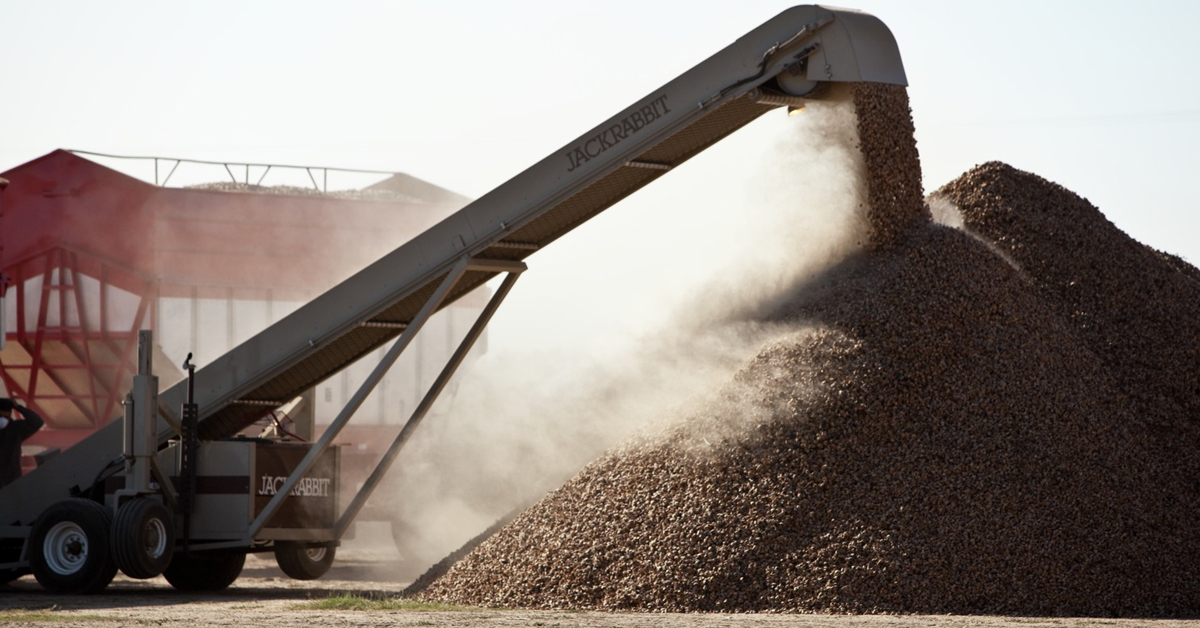As harvested almonds travel from the orchard to the huller/sheller, it is essential for industry members to take steps to protect the upcoming year’s crop from potential threats. Proactive steps are particularly important once the crop is ready to be stockpiled, before the hulling and shelling process begins. Too high of moisture level in a stockpile can lead to a number of serious quality issues, from mold and aflatoxin to concealed damage and browning of almond kernels.
 If your crop is bound for stockpiling, monitoring moisture levels prior to pick up is a good practice and can be achieved through sampling. Practical tip: Do not stockpile your crop if the hull moisture content exceeds 12%, the kernel moisture content exceeds 6% or the total fruit (in-hull almond) moisture content exceeds 9%. There is variability in the moisture levels of nuts that are drying on the ground, and it is important to focus on almonds with the highest moisture content while sampling. Prior to sweeping, the ‘worst case’ high moisture content almonds are those that are on the north side of the canopy next to the trunk. For windrows, moisture levels are higher among the bottom layer of almonds.
If your crop is bound for stockpiling, monitoring moisture levels prior to pick up is a good practice and can be achieved through sampling. Practical tip: Do not stockpile your crop if the hull moisture content exceeds 12%, the kernel moisture content exceeds 6% or the total fruit (in-hull almond) moisture content exceeds 9%. There is variability in the moisture levels of nuts that are drying on the ground, and it is important to focus on almonds with the highest moisture content while sampling. Prior to sweeping, the ‘worst case’ high moisture content almonds are those that are on the north side of the canopy next to the trunk. For windrows, moisture levels are higher among the bottom layer of almonds.
Another threat to almond quality, and another cause of high moisture levels, is rain during harvest. While rain cannot be avoided, growers and custom harvesters can mitigate moisture-related damage in the orchard. If rain is in the forecast, shaking should be put on hold until after the rain has passed, as wet nuts dry faster on the tree than on the orchard floor. However, if rain is in the forecast while the nuts are on the ground to dry, a number of steps can be taken:
- If you’ve already shaken your trees, but the nuts are still too wet to pick up, blow them away from tree trunks and don’t windrow.
- If nuts have been windrowed, condition them through a drop chute of a harvest machine. This involves picking them up and putting them back on the ground while blowing out leaves and other trash. This helps dry nuts faster even under dry conditions. Conditioning your crop both before and after rainfall promotes the most rapid drying; however, a greater benefit is seen when conditioning after rainfall.
- Maintaining optimum moisture levels before stockpiling is critical to limiting mold growth and concealed damage. If moisture or relative humidity levels are too high to stockpile, another option is to move the crop to a dry area, or machine dry.
An article written by Franz Niederholzer, a farm advisor in Colusa County, contains a table illustrating growers’ options to dry their crop across a range of harvest conditions. This newsletter article – “Coping with Rain at Harvest” – and table can be viewed here.
Growers as well as hullers/shellers are encouraged to reference the Almond Board of California’s “Stockpile Management Best Practices” guide, which provides valuable information on best practices for creating stockpiles and managing moisture levels during this busy time of year.